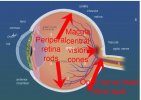About to take the Part 107 exam and asking for clarification on one thing. The blind spot in the middle of our vision in the darkness that compels us to look off center to see the object is caused by the RODS or CONES in our eyes? Thank you for your time reading this.
You are using an out of date browser. It may not display this or other websites correctly.
You should upgrade or use an alternative browser.
You should upgrade or use an alternative browser.
RODS OR CONES
- Thread starter Joe Herrera
- Start date
The blind spot is the location of the optical disc which is where the optical nerve connects to the eye ball. The optical disc has no rods and no cones, which causes a blind spot.
Hi MavikhanThe blind spot is the location of the optical disc which is where the optical nerve connects to the eye ball. The optical disc has no rods and no cones, which causes a blind spot.
Before studying the Part 107 Study Guide from Drone Launch Academy, I didn't even know there were rods or cones inside the human eye. The study guide states the rods & cones are the receivers and interpret the visual signals in our eyes. I'm am told it is a question that will be on the exam.
anotherlab
Well-Known Member
The question as you have worded doesn't make any sense.About to take the Part 107 exam and asking for clarification on one thing. The blind spot in the middle of our vision in the darkness that compels us to look off center to see the object is caused by the RODS or CONES in our eyes? Thank you for your time reading this.
In this context, rods perceive vision in low light and cones perceive color and require more light. So assuming the actual question was which part of the eye is used in darkness, the answer would be rods.
maggior
Well-Known Member
The reason they discuss it is that because of how they behave, it is easier to see things at night through your peripheral vision.Hi Mavikhan
Before studying the Part 107 Study Guide from Drone Launch Academy, I didn't even know there were rods or cones inside the human eye. The study guide states the rods & cones are the receivers and interpret the visual signals in our eyes. I'm am told it is a question that will be on the exam.
This explains it:

How Does Night Vision Work in the Human Eye?
There are about 120 million rods in your retina that are responsible for night vision. Problems with night vision can be related to other medical conditions.
I am an ophthalmologistAbout to take the Part 107 exam and asking for clarification on one thing. The blind spot in the middle of our vision in the darkness that compels us to look off center to see the object is caused by the RODS or CONES in our eyes? Thank you for your time reading this.
Peripheral vision are rods and central vision from the center of the retina (macula) are cones
Dale Davis MD
You are the best qualified to answer, and provided the key info that cones are in the center of the eye, but surely there must be a lack of any cones at the blind spot of the retina, correct?I am an ophthalmologist
Peripheral vision are rods and central vision from the center of the retina (macula) are cones
Dale Davis MD
Droning on and on...
Well-Known Member
The "blind spot" is called the fovea. it is the location where the nerves going to each rod and cone bundle together into the Optic Nerve and exit the eye structure to the brain.You are the best qualified to answer, and provided the key info that cones are in the center of the eye, but surely there must be a lack of any cones at the blind spot of the retina, correct?
There are no rods and cones at the fovea, hence the blind nature of that tiny region of the retina.
Rods and cones are roughly analogous to pixels on a bayer color image sensor. Rods are sensitive to light intensity, while there are three different cones sensitive to different frequencies of light with overlapping, gaussian response that peaks at red, green, and blue frequencies for the respective cone types. You perceive color based on the relative stimulation of the three "sensors" clustered together in any particular spot.
Because the cones are each sensitive to just a portion of the visible spectrum, they do not perform as well as rods, which respond to light energy across the visible spectrum. This is why color perception diminishes as light levels get dim, and you start to see, to the extent you can, in grayscale.
Droning on and on...
Well-Known Member
The blind spot is the head of the optic nerve and has neither rod or conesYou are the best qualified to answer, and provided the key info that cones are in the center of the eye, but surely there must be a lack of any cones at the blind spot of the retina, correct?
When your question came in I was on the tennis court. Now, at my desk, I can send this to you.About to take the Part 107 exam and asking for clarification on one thing. The blind spot in the middle of our vision in the darkness that compels us to look off center to see the object is caused by the RODS or CONES in our eyes? Thank you for your time reading this.
Dale Davis,M.D.(ophthalmology-board certified)
Miami

hiflyer201
Well-Known Member
- Joined
- Sep 27, 2018
- Messages
- 2,740
- Reactions
- 2,167
I’ve been flight instructor for about 60 years. This has alway been a study topic as it concerns night vision and how scanning for traffic at night differs from scanning during daylight, and also the importance of protecting you night vision.
You have to admit it’s pretty interesting. H
You have to admit it’s pretty interesting. H
Please do not feel offended but it is not the optical disc, it is the optic disc or the optic nerve head. Some also refer to this part of the eye anatomy as the papilla.When swollen , it is called papilledema.The blind spot is the location of the optical disc which is where the optical nerve connects to the eye ball. The optical disc has no rods and no cones, which causes a blind spot.
Dale Davis M.D. Board certified Ophthalmologist, Fellow American College of Surgeons
None taken.Please do not feel offended but it is not the optical disc, it is the optic disc or the optic nerve head. Some also refer to this part of the eye anatomy as the papilla.When swollen , it is called papilledema.
Dale Davis M.D. Board certified Ophthalmologist, Fellow American College of Surgeons
I appreciate the graphic you sent explaining this, but this question on the Part 107 exam is still asking whether it's rods or cones that causes the blind spot in the night vision. I'm just trying to find how to correctly answer this question on the exam.When your question came in I was on the tennis court. Now, at my desk, I can send this to you.
Dale Davis,M.D.(ophthalmology-board certified)
Miami
View attachment 164236
Droning on and on...
Well-Known Member
Are you sure you're getting the question right?I appreciate the graphic you sent explaining this, but this question on the Part 107 exam is still asking whether it's rods or cones that causes the blind spot in the night vision. I'm just trying to find how to correctly answer this question on the exam.
Neither rods or cones cause the blind spot. It's the absence of either at the Optic Nerve head that makes that spot blind.
CORRECTION: I identified the "blind spot" as the Fovea, which was in error. The fovea is near the Optic Nerve head, but is in fact the area of greatest vision acuity, the center of vision.
I appreciate @Dale D, our resident Ophthalmologist, for not knocking me around for misremembering some of the anatomical names.
My excuse is I'm just a lowly engineer. Ask me about bridges
The kind you drive over. The other kind will have to be handled by one of our resident dentists
Walleye Hunter
Well-Known Member
I'll take stuff on the test that has no relevance in real life for $1000, Alex. The last time I recall anything about this was when I was studying for my private pilot's license over 20 years ago.
NightFlightAlright
Well-Known Member
Rods are very sensitive to light and are responsible for our night vision only, as they become bleached (overloaded) at very low levels of light (8 cd/m² is about the point of too bright for the rods). Rods are monochromatic, and have a peak sensitivity at a wavelength that we were generally consider teal, however we don't really have color perception in our night vision.
Cones come in three varieties, and are responsible for our daytime color vision. The three varieties are called L M S for long wave medium wave and short wavelength, relating to the wavelengths of light they most respond to.
The L cone extends all the way down to what we would call deep red but has peak sensitivity in yellow, the M Cone does not extend down as far and peaks in a deeper green. The S Cone peaks in a deep blue violet.
Only the L and M cones exist in the central foveal vision. Rods and S cones exist in the peripheral vision, and L&M cones exist there as well, but in less dense numbers than in the central foveal vision. The highest resolution area of our vision is the central foveal area, a very narrow area—if you outstretched your arm and then look at your thumb, your thumbnail is a bit larger than your central foveal area in terms of the visual angle.
The blind spot caused by the optic nerve is a distance away from the foveal central vision, and it has neither cones nor rods.
L and M cones combine to make the luminance channel which is the achromatic lightness/darkness which in the human vision system contains all of the spatial detail. And while we have many more rods than cones, the rods are grouped together in such a way that our night vision is at a much lower resolution than our daytime vision.
The reason red is sometimes used in places such as dark cockpits at night, is that it stimulates the L cone while avoiding any stimulation of the rods, so that it doesn't affect the dark adaptation/night vision.
--------
Thus, because there are no rods in the central foveal pit, we have no night vision in our central vision, which is why when we are using only our rods we are also using only our peripheral vision. This has nothing to do with the blindspot that is caused by the optic nerve which is a completely separate physiological issue.
Cones come in three varieties, and are responsible for our daytime color vision. The three varieties are called L M S for long wave medium wave and short wavelength, relating to the wavelengths of light they most respond to.
The L cone extends all the way down to what we would call deep red but has peak sensitivity in yellow, the M Cone does not extend down as far and peaks in a deeper green. The S Cone peaks in a deep blue violet.
Only the L and M cones exist in the central foveal vision. Rods and S cones exist in the peripheral vision, and L&M cones exist there as well, but in less dense numbers than in the central foveal vision. The highest resolution area of our vision is the central foveal area, a very narrow area—if you outstretched your arm and then look at your thumb, your thumbnail is a bit larger than your central foveal area in terms of the visual angle.
The blind spot caused by the optic nerve is a distance away from the foveal central vision, and it has neither cones nor rods.
L and M cones combine to make the luminance channel which is the achromatic lightness/darkness which in the human vision system contains all of the spatial detail. And while we have many more rods than cones, the rods are grouped together in such a way that our night vision is at a much lower resolution than our daytime vision.
The reason red is sometimes used in places such as dark cockpits at night, is that it stimulates the L cone while avoiding any stimulation of the rods, so that it doesn't affect the dark adaptation/night vision.
--------
Thus, because there are no rods in the central foveal pit, we have no night vision in our central vision, which is why when we are using only our rods we are also using only our peripheral vision. This has nothing to do with the blindspot that is caused by the optic nerve which is a completely separate physiological issue.
Last edited:
Similar threads
- Replies
- 11
- Views
- 968
- Replies
- 19
- Views
- 2K
- Replies
- 13
- Views
- 3K
- Replies
- 80
- Views
- 3K
DJI Drone Deals
New Threads
-
Air 2s Ronda, the most well known of the White Villages of Southern Spain
- Started by FlyingDutchman90
- Replies: 0
-
-
-
-












